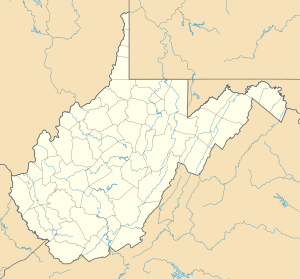Battle of Charlestown
| Battle of Charlestown | |||||||
|---|---|---|---|---|---|---|---|
| Part of the American Civil War | |||||||
| |||||||
| Belligerents | |||||||
|
|
| ||||||
| Commanders and leaders | |||||||
| Benjamin L. Simpson | John D. Imboden | ||||||
| Strength | |||||||
| 1,125 | 1,900 | ||||||
| Casualties and losses | |||||||
| 452 (22 killed, 50 wounded, 382 captured) | 61 (40 killed and wounded, 21 captured) | ||||||
Location of the battle in West Virginia | |||||||
The Battle of Charlestown was a small engagement between
Background
As the Confederate
Battle
At dawn on the 18th, Union pickets south of Charles Town were driven back by Imboden's advance. Simpson's
Meanwhile, back in Charles Town, Imboden brought up his artillery, and again demanded the garrison's surrender, which was rebuked for a second time, whereupon Imboden began to shell the town. Under the artillery fire, Simpson was forced to abandon the courthouse and marched his men to a field northwest of town, not far from the earlier cavalry engagement. Imboden massed his forces in a woods facing the field and unleashed a deadly volley. After several minutes and only a few shots fired in return, Simpson finally surrendered his force, now totaling some 365 men.
The artillery fire had not gone unnoticed in nearby Harpers Ferry; the 17th Indiana battery, Cole's Maryland Cavalry, and the remainder of the Loudoun Rangers and 6th Michigan, totaling 300 men in all, were dispatched to reinforce the besieged garrison. Within 15 minutes they had engaged Imboden's force and a fierce firefight ensued that lasted the entirety of the afternoon. The reinforcements, however, were not strong enough to drive off Imboden and liberate the prisoners.
At around 5 p.m. the
Aftermath
Imboden successfully attacked and defeated the Union garrison at Charles Town, exposing the weakness of Union forces in the Shenandoah Valley, taking only light losses. While his raid was successful, it had little overall impact on the fall campaigns, which ended shortly thereafter as the two armies went into winter quarters. For the Union's part, at considerable loss, they saved Charles Town from being sacked and burned and turned back Imboden's raid, which if had been allowed to continue may have had a larger strategic impact on the campaign in central Virginia.
References
- Goodheart, Briscoe, History of the Independent Loudoun Rangers: U.S. Cav. (Scouts) 1862-1865. McGill and Wallace; Washington, D.C., 1896.

